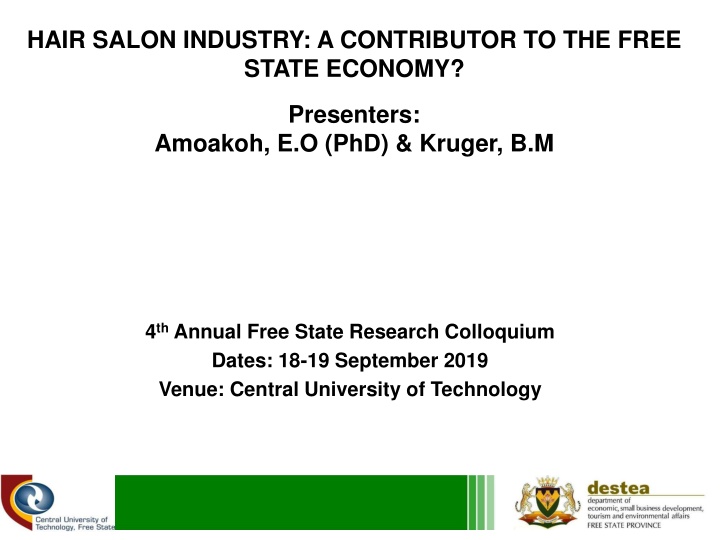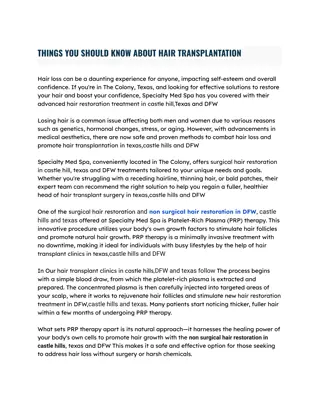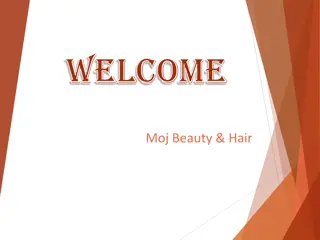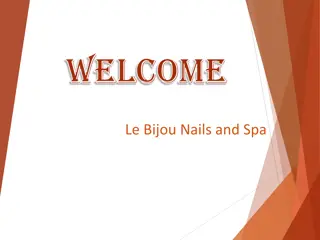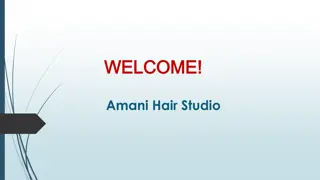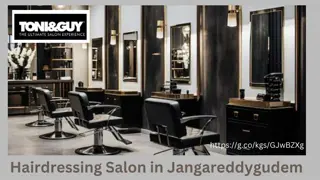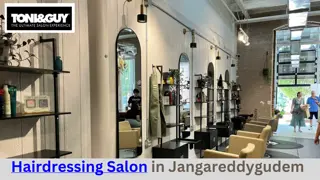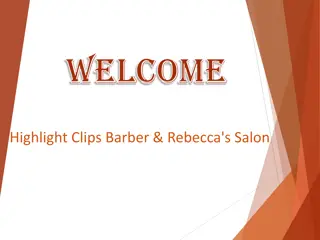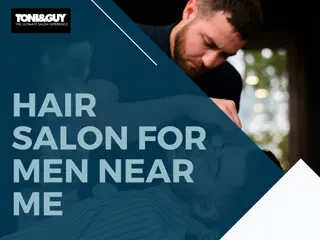Economic Impact of the Hair Salon Industry in Free State
The hair salon industry's significant contribution to the economy of Free State is analyzed, with insights on global hair care market growth, the thriving black hair care sector in South Africa, and its implications for the region's economic development strategies.
Uploaded on Feb 26, 2025 | 0 Views
Download Presentation

Please find below an Image/Link to download the presentation.
The content on the website is provided AS IS for your information and personal use only. It may not be sold, licensed, or shared on other websites without obtaining consent from the author.If you encounter any issues during the download, it is possible that the publisher has removed the file from their server.
You are allowed to download the files provided on this website for personal or commercial use, subject to the condition that they are used lawfully. All files are the property of their respective owners.
The content on the website is provided AS IS for your information and personal use only. It may not be sold, licensed, or shared on other websites without obtaining consent from the author.
E N D
Presentation Transcript
HAIR SALON INDUSTRY: A CONTRIBUTOR TO THE FREE STATE ECONOMY? Presenters: Amoakoh, E.O (PhD) & Kruger, B.M 4thAnnual Free State Research Colloquium Dates: 18-19 September 2019 Venue: Central University of Technology
GLOBAL PERSPECTIVES OF CHARE CARE IN GENERAL 1. Growth in the hair care market has been encouraging. Millions of consumers in developing economies are now becoming conscious about styling their hair, colouring grey hair, and maintaining a healthy scalp. 2. In 2018, the global hair care market was estimated to be worth about 87.73 billion US dollars. 3. In UK, hair dressers and other beauty salons turnover was approximately 4.2 billion pounds. Number of hair dressers grew up to 40, 876 in 2016 across the country. 4. In Germany, barber shops increased by 2% growth in 2016. 5. In US, hair care market value in 2016 was 459.9 million US dollars.
BLACK HAIR CARE IN SOUTH AFRICA 1. Salon visits, especially in the informal sector, have recorded high growth for the black hair care market and realised that South Africa represents one of the more mature hair care markets in Africa. (https://www.mordointelligence.com/industry). 2. Between 2010 and 2015, hair care was amongst the fastest growing categories of products sold in South Africa, with sales climbing 38% during that period, (Euromonitor report). 3. The same document also found that the African hair care market accounted for about 450 million US dollars in sales in South Africa, i.e. 6.3 billion rands. 4. According to the Professional Hair Care Market SA 2010 Report found that the ethnic African segment is the single largest consumer group which has the most potential .
BLACK HAIR CARE IN SOUTH AFRICA 5. The document further asserts that Black consumers spend up to six times more than their White counterparts when it comes to hair care. 6. Notable hair industries include FRIKA Hair Company which estimates that the South Africa Black hair market is worth at least R4.5 billion, dedicated to supplying braids, weaves, wigs and hairpieces. https://www.mordorintelligence.com/industry-report/south-africa-hair- care-market-industry. 7. According to the 2017 Mintel Report, another trend in the hair care industry in South Africa is that consumers are embracing natural hair care brands. 8. In terms of hair products use in South Africa, dominant players of products include L Oreal SA, with more than a quarter of market share, followed by Proctor & Gamble and Unilever SA, while Diagonal 2010 report found that relaxers and weaves still dominate the South African market.
DESTEAS PERSPECTIVE The Free State Growth and Development Strategy and the Provincial Economic Development Strategy (PEDS) focus on the prioritised sectors; Agriculture, Tourism, Transport, Mining & Manufacturing. Free State GDP 2015: Highest contributors were government services 15.4%, finance at 14.9%, trade industries at 12.7%. Manufacturing contributed 10.2% to the GDP of the province (registered an increase of 1% compared to its contribution in 2012 (StatsSA GDP, Q4: 2016). Personal services, under which hairdressing is classified, contributed 7.1% to the GDP of the province in 2015, which represents an increase of 0.1% compared to its contribution in 2014. Therefore, upward trend of personal services (2014 versus 2015) and its linkage (in the context of the hair industry) with the manufacturing sector is promising potential to change the local economic landscape.
DESTEAS PERSPECTIVE Considering the size of hair salon industry, it is important to ensure that it creates jobs for people of the Free State and leverage it to strengthen the manufacturing sector. However, due to insufficient information it and that the haircare component of the industry is largely informal, it was difficult to make evidence-based decisions. Programme 3: Economic & Small Business Development Purpose of this programme: to manage and coordinate economic development activities to grow the FS economy. Mandate is achieved through trade & investment promotion, SMME development and support and economic research. Despite DESTEA s supporting hair salons with R1.8 million during the 2017/18 and 2018/19 financial year those SMMEs kept struggling.
AIM OF THE STUDY AIM OF THE STUDY To determine the factors and the support needed by the hair salons to achieve growth to create more jobs in the Free State province. To establish the hair salon industry linkages with the manufacturing sector value chain for opportunities to find expression in the provincial economy. To ascertain the estimated turnover trends for establishing a salon. To identify the sources of hair care products by the salons. To analyse the opportunities available in terms of salons linkages with manufacturing value chain. 7
RESEARCH METHODOLOGY The project was managed by a Steering Committee; DESTEA, Treasury and OTP. The study covered five districts and their metropolitan municipalities. These consists of a. Fezile Dabi, Lejweleputswa, Mangaung, Thabo Mofutsanyane, Xhariep. Each district was represented by an employee of the Destea service centres to assist the research team in recruiting field workers for the research.
RESEARCH METHODOLOGY Research design: descriptive, quantitative and qualitative research approaches were used. Population of the study: all companies/entrepreneurs (formal and informal) participating in the salon industry in the province and manufacturers/retailers of hair products. Data collection: Census and survey methods (interviews). Data analysis: Data collected was analysed using the SPSS statistical computer software package proven to produce reliable inferential and descriptive statistics. Ethical issues: This empirical research adhered to all prescripts of conducting ethically sound research.
SUMMARY OF THE RESEARCH FINDINGS 1. Hair salon ownership according to nationality, gender, age and designated groups 60% of salons in the Free State province owned by non- South Africans. Majority of hair salon operators are 40 years and above and 25 years and below. In terms of gender, main report seem to be in line with the view that there is no disparity between male and female participants.
SUMMARY OF THE FINDINGS RESEARCH FINDINGS 2. Estimated capital outlay for establishing hair salons in the FS province Findings indicated that the average start-up capital outlay is mostly R20 000. Next higher estimation was between R51 000 and R60 000. 3. Turnover trends among hair salons in the Free State Estimated daily sales were less than R300 (54%) while monthly profits were less than R10 000 (85%). 4. Sources of hair care products used Majority of participants (75%) source hair products from accessible retailers who are mostly in the Free State. Hair salon operators typically patronize both the wholesalers and producers across the country were found to make up 22% and 3% respectively.
RECOMMENDATIONS RECOMMENDATIONS 1. Recommendation for the incentivization of emerging hair salon operators Given that most of the emerging and survivalist hair salon operators were found to be owned by black South African, and having not more than matric, some support interventions are required. Interventions that can improve their sustainability and lead to the creation of more job opportunity can be demonstrated by means of the incentive scheme.
RECOMMENDATIONS 2. Recommendation for the Continuous evaluation of the emerging hair salon operational performance It is recommended that DESTEA and the relevant government authorities ensure the reinforcement of a continuous evaluation of the emerging hair salon operational performance. The support for the reinforcement of skills acquisition for the emerging hair salon operators is recommended. Existing training and development programmes must speak to the critical needs of the industry in the Free State province. This recommendation addresses the findings regarding education, and highest training obtained.
RECOMMENDATIONS 3. Recommendation for policy actions to encourage investments in the manufacturing of hair care products and accessories in the Free State province. It was found in the literature review and the interview that majority of the popular brands of hair care products were sourced from outside of the Free State province. The study, therefore, recommends for policy actions to encourage investments in the manufacturing of hair care products and accessories in the province. By this recommendation, attracting and retaining manufacturing investments in the hair care products and cosmetics within the province can expand the industry s capacity to create more job opportunities and boost the economy of the province.
RECOMMENDATIONS 4. Recommendation for a revolving apprenticeship model of accelerating hair salon entrepreneurship A revolving apprenticeship model of accelerating hair salon entrepreneurship may require the collaboration of both the government and established hair salons. This model should be aimed at providing apprenticeship opportunities for prospecting hair salon entrepreneurs to acquire a comprehensive set of skills that can include the management of hair salons. Therefore, a recommendation of the establishment of hair salon academy in the province.
RECOMMENDATIONS 5. Standardization of the informal hair salon operations Following the ongoing debate regarding the formalization of the informal sector of the economy, it is evident that the contribution of the informal sector such as hair salons to the GDP of the economy of South Africa has remained applaudable. This study, therefore, recommends for the standardization of the informal hair salon operations.
LIMITATIONS This study identifies two key constraints, namely, methodological and administrative constraints all of which were encapsulated in time and finance. The uncertainty associated with the political will of government can be factored into a range of possible constraints, both to demonstrate the findings and recommendations of this study.
RECOMMENDATIONS FOR FUTURE RESEARCH This study sees the need for future research that will include the cosmetologists as participants which would have allowed for the expansion of the scope of the research. Future research should consider the contributions of the two umbrella organizations of the hairdressers in the Free State province for a more robust insight.
Thank you 26
